All the wood based panel which using melamine Laminate technology can be called melamine boards. Common melamine board based with MDF board, particleboard, and plywood. Melamine MDF board, as the name implies, is based of MDF, melamine paper can be various colours, white, black, wood grain,etc.
Usually, when we talk about Melamine boards, we talk about Laminates and baseboards. But in fact is much more complexed. Laminate is generally composed of ① surface paper, ②decorative paper, ③cover paper, and ④bottom paper.
① The surface paper is placed on the top layer of the decorative board. It protects the decorative paper and makes the surface of the board after heating and pressing highly transparent. The board surface is hard and abrasion-resistant. This paper requires good water absorption, white and clean, and transparent after dipping.
② Decorative paper, that is, wood grain paper, is an important part of the decorative board. It has a base color or no base color and is printed into various patterns of decorative paper. It is placed under the surface paper and mainly plays a decorative role. This layer requires Paper has good hiding power, impregnation, and printing performance.
③ Cover paper, also called titanium white paper, is generally placed under decorative paper when manufacturing light-colored decorative boards to prevent the underlying phenolic resin from penetrating the surface. Its main function is to cover the color spots on the surface of the substrate. Therefore, good coverage is required. The above three types of paper were each impregnated with melamine resin.
④ Bottom paper is the base material of the decorative board. It plays a role in the mechanical properties of the board. It is made by impregnating with phenolic resin glue and dried. Several layers can be determined according to the application or the thickness of the decorative board during production.
To turn the papers to laminates, we need to impregnating them in melamine resins, mealmine resin is used for stick the paper on surface of MDF.
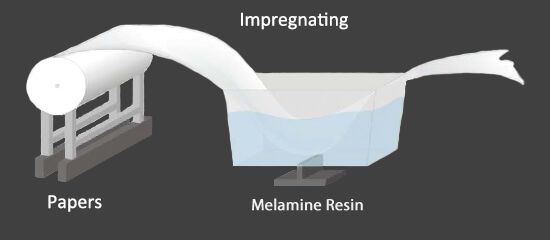
when we had Melamine Laminates, then use a hot press machine to laminated it with MDF Board.

This the process how the melamine MDF board be produced.The Impregnating Process normally finished by the laminates factory, then we buy melamine laminates from them and produce melamine Paper
You can also view the above video to see how it works.
If you are interested in melamine melamine MDF , please see more at https://chinafiberboard.com/
We warmly welcome wholesalers, traders, furniture factories, construction projects team to contact us freely.
We definitely will provide you with both high quality goods and great service.
Hangzhou Fengyuan Wood Co.,Ltd
Web: https://chinafiberboard.com/
Tel: +86-571-86063713
Whats app: +8615868403313
Email: sales@fengyuanwooden.com
One of the key areas to ask about when shopping for laminate and engineered wood floors is the core layer, which we talk about a bit on our 5 Things You Need To Know Before You Buy Laminate Flooring. The materials typically used in the making of a core layer is high-density fiberboard (HDF) and medium-density fiberboard (MDF). Given that it is an important aspect when it comes to the anatomy of a floor, and important when you’re buying floors, I thought it made sense to talk about it a bit.
Fiberboard is a wood byproduct, known as an engineered wood product because raw materials are taken and processed into a versatile and durable material. It’s used in flooring as core material, of course. But, it’s also used for furniture manufacturing, designed not to split or crack.
Fiberboard is made through a compression process, where wood fibers are bonded together, specifically for the use of backing or of reinforcing a veneer, and most often with a resin to keep it stable. On laminate flooring and engineered hardwood floors, the fiberboard core are sandwiched between the decor layer or veneer layer, and the backing layer.
Take a look:
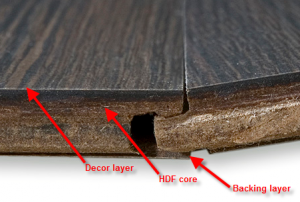
HDF is MDF are made in a similar process, although the compression levels are in a slightly lower range with MDF from 600-800 kg/m3. HDF is processed in a range from 600-1450 kg/M3. Fiberboard cores are checked for emissions levels, both when they’re manufactured, and afterward too before they’re shipped as product. This is mainly due to the use of resins and glue that are used to bind the materials, and the importance placed on reducing off-gassing as much as possible.
One of the pieces of advice is to always choose HDF when shopping for laminate floors, if you can. The ressistance to moisture, and to shrinkage and expansion in HDF is much higher. This makes for a more stable core, which is the job of the core in any case – to give you a more stable floor overall. MDF will still serve you, of course. But, HDF is preferable for better performance.
Introduction
Medium density fiberwood (MDF) is a synthetic building material used in wooden constructions. Both softwood and hardwood are broken down into wood fibers in a defibrator which are then combined after treatment with resin and wax. These wood fibers are pressed at high temperatures and pressures to get MDF panels. With its introduction in the 1980s, MDF has been in existence for quite some time now. Its sturdiness and cost effectiveness have made it popular in constructions as well as manufacture of cabinets and cupboards. Along with its many advantages, MDF has its own disadvantages and here we shall discover the pros and cons of this relatively new building material over traditionally used wood.
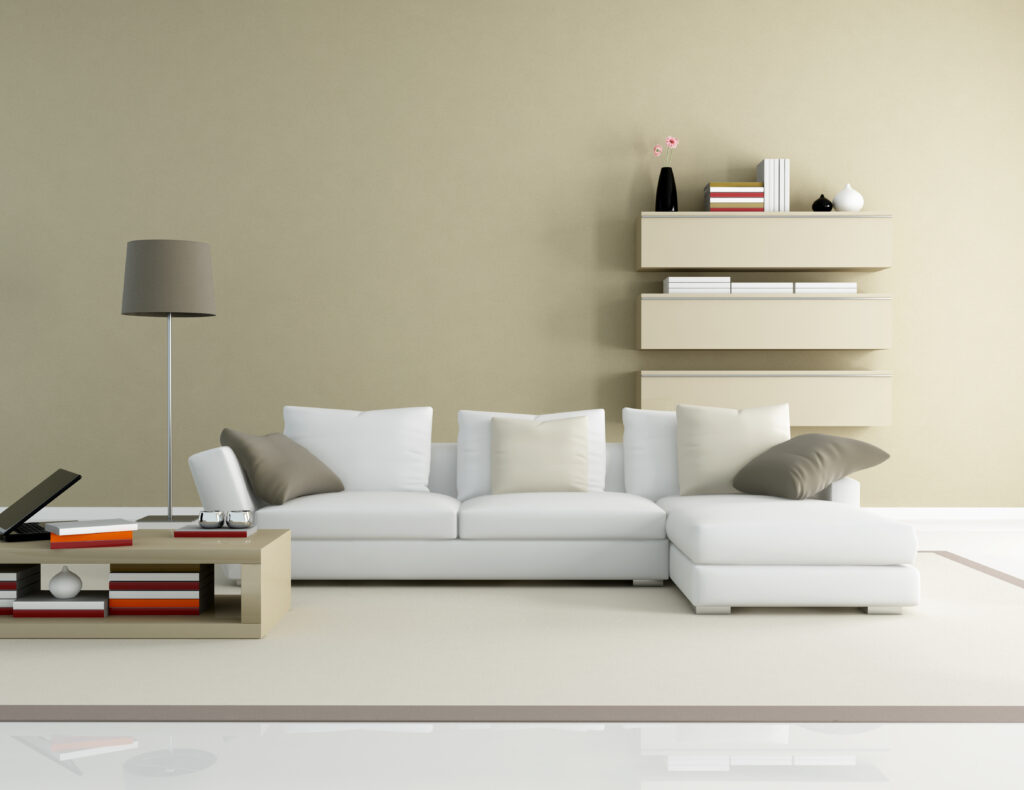
Advantage of MDF Furniture
1.MDF is an economical choice. It's inexpensive to make so you will pay less for it in the store than for some solid wood pieces.
2.MDF uses recycled wood in its construction, thereby helping to save trees.
3.MDF is easy to paint in many different colours, whereas solid wood has a difficult time taking some colours.
A smooth material throughout, MDF does not have knots that can blemish the surface of a piece or make components difficult to attach.
4.The chemicals used in the construction of MDF make it poisonous to pests such as termites.
5.MDF will not expand and contract due to heat and humidity the way solid wood can.
6.Shaping MDF is easier than shaping solid wood, making it easier to do more elaborate designs.
Veneer can easily be attached to MDF to give it the look of genuine wood.
Disadvantages of MDF Furniture
1.As noted above, when MDF is being constructed, it may off-gas small amounts of formaldehyde, though this has largely dissipated by the end of the construction process. MDF which has been painted reduces any health risk still further.
2.MDF tends to be high maintenance - if you chip it or crack it, you cannot repair or cover the damage easily as you typically can with solid wood.
3.The chemicals used in making MDF make the material less child-friendly than other materials.
Direct exposure to water can cause MDF to swell.
4.There is no grain on MDF, as it is not a natural wood product. If this is an issue, however, it is easily remedied with veneer.
5.The glue present in MDF can make it hard to sink certain types of fasteners into the material.
Wood venner is a wood flake material produced by rotary cutting or sawing. Its thickness is usually between 0.4-2.0mm, which is mainly used to produce plywood and other plywood. Generally, high-quality veneer is used as the panel of plywood, blockboard, formwork, veneer, and other artificial boards. Graded veneers can be used as backboards and core boards.
Veneer is a product that consumes a lot of labor. There are many such kind of products.

How to select a good veneer?
Size and hardness considerations:
A ) Length: Generally speaking, the longer the veneer, the more stable it is, suitable for high-speed taxiing, and the shorter the board, the more flexible it is, suitable for use in parks and props. But which range is more appropriate? Presumably everyone already has a certain understanding. Stand up the board, no higher than your nose, and no lower than your shoulders. Someone here might ask, isn't it between the chin and the nose? BOARDZONE here refers to the length exclusive to playing props (almost all foreign PROs have two lengths, respectively, for high-speed taxis such as large jump platforms or mountains that require speed, and short boards used in parks and props) ). And the shortest length for prop movement is suitable around the shoulder.
B) Width: Generally speaking, the board selected according to height is basically suitable in width, but some players with larger feet may find that the board is long enough and not wide enough (the standard is to place the retainer and boots at a customary angle. After that, if there are too many parts that are wider than the board surface—for example, all 5 feet are outside—the board is not wide enough, and it is easy to accidents because the board cannot slide normally when sliding. Note, however, that boots and holders that are slightly wider than the board are normal.
C)Hardness: Hardness is also a key choice when choosing a veneer. Generally speaking, the harder the board is, the more stable it is at high speeds, suitable for maintaining speed. The softer the board is, the easier it is to complete the fancy action in FREESTYLE. You should choose different hardness according to your favorite way of sliding. One thing that BOARDZONE wants to remind everyone here is also often overlooked: the body weight also plays a big role in choosing different types of hardness. For people of the same height, the heavier one should use the harder board, while the lighter one can choose the softer board. General veneer companies have different standards on the different products introduced, indicating their suitable taxiing methods and player weights, etc., everyone should pay attention to reference when choosing. Because different companies have different standards for different models, BOARDZONE will not list them here.
MDF is called medium density fiberboard, density ≥800 kg/m³ called HDF, means high density fiberboard.
So what are the advantages of MDF & HDF? Now let us explain it.
1. MDF & HDF is not easy to bend or crack. Although MDF is technically made of wood, its structure is completely different. If you try to bend the MDF board, it would rather grab rather than warp. This is why engineered wood has the advantage of different moisture resistance from its opponents. Of course, if you sink it into the water, the circuit board will be damaged sooner or later. However, if you expose it to moisture in the air, the part will expand and contract as a whole, while keeping the overall integrity and shape intact.
2. MDF & HDF is more affordable and easier to supply. Generally speaking, the price of MDF board is lower than that of natural wood. Of course, if you compare high-end MDF with some lower-priced wood, there are some exceptions. Another great benefit of engineered wood is that you will find it easier than maple or white oak, especially if you need a specific size.
3. MDF & HDF is easier to paint and seal. In contrast to solid wood, engineered wood does not have any specific texture or texture. This means that it is easier to sand and prime without having to worry about the appearance or the worst case-knots.
4. MDF & HDF is most suitable for cabinets. The advantages of engineered wood for cabinet doors are indisputable. The flexibility of manufacturing allows interior designers to choose between flat, partial, full coverage, embedded, European and raised designs. Many types of MDF have additional moisture resistance, which is essential for kitchen and bathroom furniture.
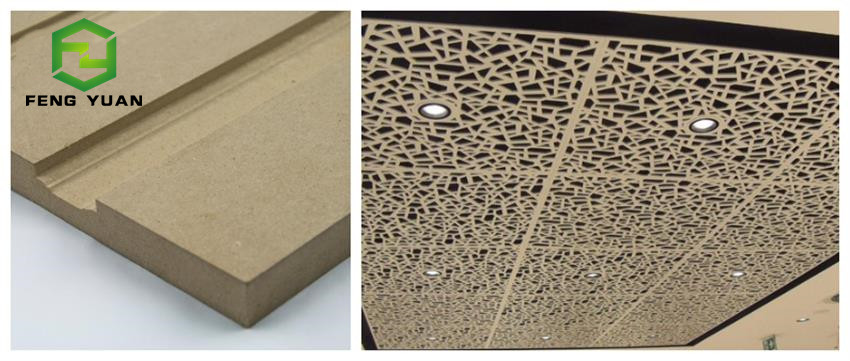
When buying boards, I wonder if you have noticed such a special board -fire-retardant MDF board. The intuitive characteristic of this type of board is the red or pink appearance, which is distinguished from ordinary density boards by adding red dye during the production process. Its flame-retardant properties are also formed by adding flame-retardant chemical components during the manufacturing process.
Fire-retardant panels have attracted a lot of attention since they came out. Because of their superior flame-retardant and safety performance than ordinary MDF, it has been widely used in international brand display props, entertainment venues decoration, domestic shopping malls Cinemas, airports, hotels and other public places.
Due to the uneven quality of the fire-retardant boards circulating in the market, how to buy high-quality fire-retardant MDF? Here, FengYuan will briefly introduce to you the three purchase techniques of fire-retardant MDF:
1. Brand identification method
Flame-retardant MDF is a product with relatively high production technology requirements. Generally speaking, only larger manufacturers have the ability to produce. When buying flame-retardant MDF, pay attention to the side of the board. Big brands will indicate their factory name, flame-retardant grade and other information on the edge.
2. Flame retardant report identification method
When purchasing, you can ask the dealer to provide the flame retardant grade test report, the test report will list the flame retardant grade of the board in detail, and the parameter information is for the purchaser to view. Since most manufacturers will only test some representative sizes, when the required size is not reported, it is also possible to select a test report of a similar size.
3. Identification method of excellent dealers
It is also a better way to choose an excellent and well-known board distributor. Such distributors have a long history of development, possess brand value, and have more reliable board quality.
As one of the company's high-quality products, the flame-retardant board has indeed been favored by many buyers for its own excellent performance, and its future application scope and development space will be broader.
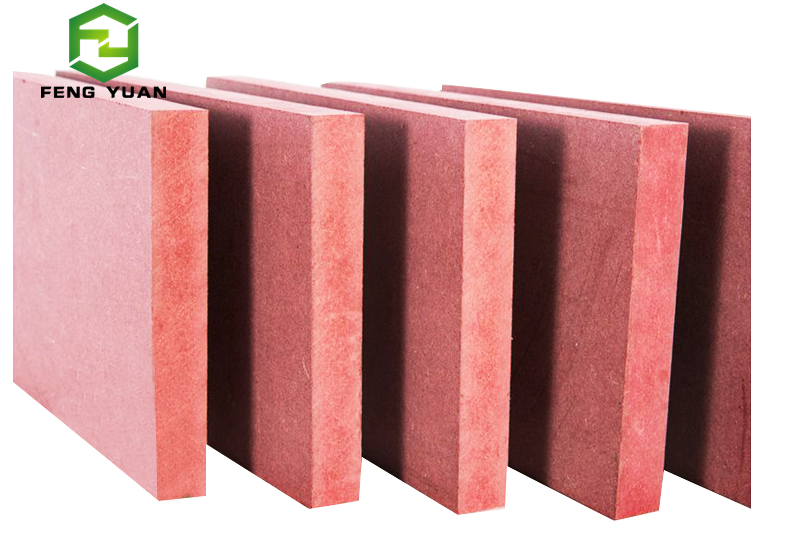
Many people wondering the difference between MDF vs solid wood. MDF is an abbreviation for Medium Density Fiberboard. People tend to look down on MDF and automatically assume solid wood is the better choice.
Of course, solid wood, like anything has its pros and cons. The benefits of solid wood: it’s strong, sturdy, and features a beautiful natural look to it with grain patterns. If you’re looking for something to last forever, solid wood is a great choice. Each species of wood is different and some have longer longevity than others, but people are drawn to it. We love to have the authenticity of solid wood, which I completely understand. The beauty of natural wood is unbeatable.
However, wood contracts or expands when it is exposed to changing heat and humidity. Unless your home is a controlled climate, cabinets made from wood can shrink or crack over time. Something most people don’t even think about is the possibility of bug infestation in your wood. It is vulnerable to pests which means it requires some maintenance.
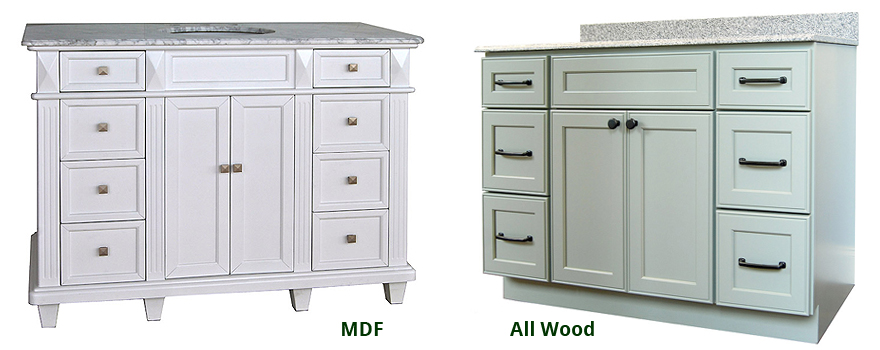
I’ve had so many people turn away the minute they hear there is MDF in a product. Man-made products are not as popular as the natural material. But why no love for this product? MDF is a high grade, composite material. It is made from recycled wood fibers and resin. It is dried and pressed to produce dense, stable sheets. Because of this process, MDF does not warp or crack like wood. And since MDF is made from small particles, it doesn’t have noticeable grain patterns. This will result in a smoother finish on the cabinets. MDF is also less expensive, which is sometimes a big selling point for some people. Depending on budget, others are willing to spend the extra money to purchase the all wood cabinets.
Copyright © 2024. Hangzhou Fengyuan Wood Co.,Ltd All rights reserved.